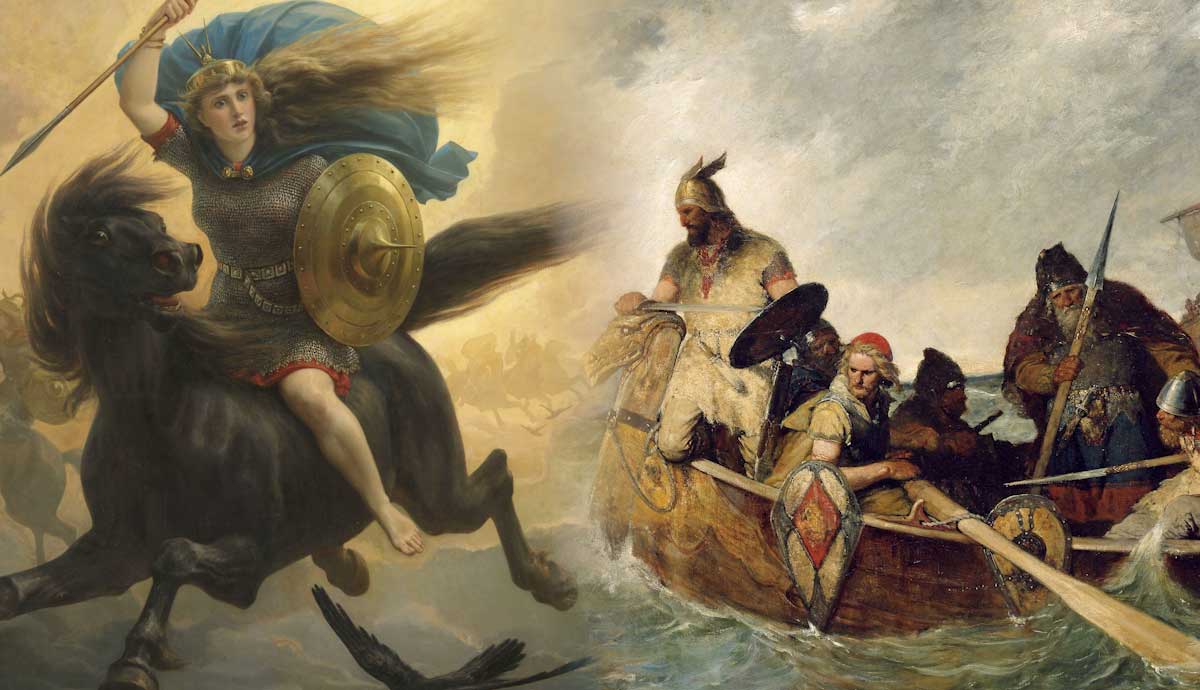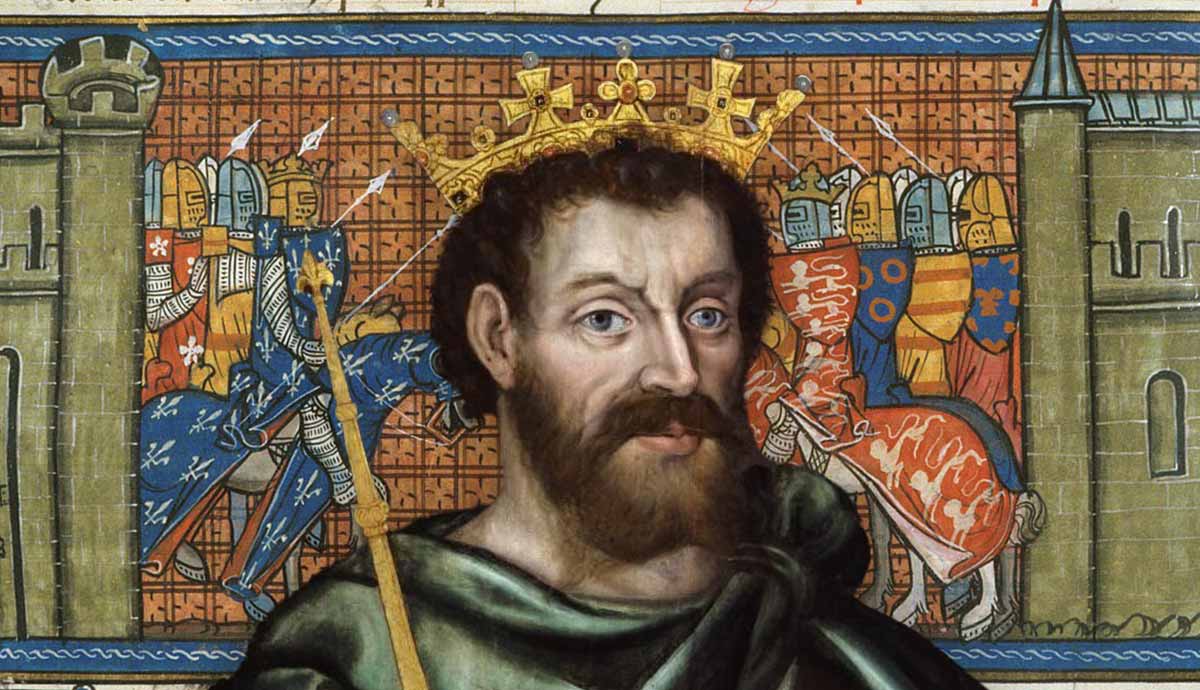
Viking berserkers and shieldmaidens are fascinating aspects of a conglomerated culture that gave way to myth and legend. Today, popular media have romanticized and dramatized these ancient warriors to suit the wants of modern audiences. While berserkers and shieldmaidens did assuredly exist in one form or another, it is hard to decipher the Viking sagas and poems and separate the facts from the fiction.
Berserkers: What Are the Facts?

The word ‘berserk’ is often associated with blind fury and rage. While the etymology of the anglicized term ‘berserk’ is often debated, most agree it was used to describe warriors that were more fearless and extreme than ‘regular’ Vikings. Adding confusion to the topic, the word ‘berserk’ may have variable representations. It may mean “bare-sark,” or “bare of shirt” referring to the habit of going unarmored or even unclothed into battle. The Icelandic historian Snorri Sturluson (1179–1241) recounts of this tradition in his Ynglinga Saga:
“They went without shields, and were mad as dogs or wolves, and bit on their shields, and were as strong as bears or bulls; men they slew, and neither fire nor steel would deal with them; and this is what is called the fury of the berserker.”
Others have understood the term to mean “bear-sark” or “wolf-skin”, úlfheðinn (Grettir’s Saga), after the animal skins they were often described as wearing. The skald Thorbjörn Hornklofi who, unlike epic saga singers, embellished the truth within limits, narrates in his poem Haraldskvadet of Harald Fairhair’s victory (ca. 872) that the berserkers roared and the wolf-skins howled. Although this implies two different groups, they are often presented as one. This picture of Viking warriors going into battle solely clothed in animal hides or coats led to the myth of the berserkers as shape-shifters.
The Berserkes as Shape-shifter?

The concept of berserkers as animal shape-shifters has become relatively mainstream in popular media during the past few decades. The resurgence of Viking mythology by comic book heroes such as Thor, books such as Tolkien’s The Hobbit, and TV series such as the History Channel’s Vikings, has played a role in this. However, the source of this concept goes back to the skaldic poetry of the Poetic Edda and the Prose Edda. As conglomerates of anonymous writings, etchings, and archaeological evidence, these Eddas make for hard-to-evaluate conclusions; especially as the Vikings were fond of presenting mythical and legendary tropes alongside factual information. Still, the theme of animal shifters in their writings appears to be an allegory for violence, madness, and wildness.

Whether about some kind of physical, mental, or emotional shape-shifting, the berserker state was the pinnacle of a warrior both revered and feared and surely not to be trusted. Additionally, while the shape-shifting of mythological monsters and the gods — primarily Loki and Odin — frequently occurred in Old Norse tales, human shape-shifters were not acceptable in these stories (Snoori, Gylfaginning and Skáldskaparmál).
In Egils saga Skallagrímsonar, Gyda details to Egil how Ljot — a berserker — asked his daughter’s hand in marriage. However, as the shape-shifter was hated by everyone, he declined. The eventual villainization of berserkers may have to do with the Christianization of Viking writers who saw Old Norse gods and stories as heathen and outdated.
As Elite Shock Troops

Whether depicted as shape-shifters or not, the berserkers were the shock troops of the Viking world. According to the sources, their extreme thirst for war, associated with the god Odin, meant that they were extremely competent. Fighting in small groups, their appearance on the battlefield, especially in a near-naked state, terrified the enemy. As mentioned earlier, in Harald Fairhair’s victory at the battle of Hafrsfjord, small groups of 12 berserkers attacked dressed only in animal skins.
However, a berserker’s frenzied, uncontrollable state could become a double-edged sword. In 1030, Olav Harraldsson discovered this when he sent his elite brotherhood of berserkers to the front of his lines. Unable to hold, the berserkers preemptively attacked, thereby contributing to Olav’s defeat and death. As the use of berserker warriors slowly faded — some kings even outlawed them — the term ‘berserk’ went on to describe ‘a mad state’ or ‘rage’, an ideal swiftly picked up by modern-day iconography.
Did They Wear Horned Helmets?

Horned helmets indeed appear in tapestries — see the Oseberg tapestry — and metalwork, although the practicality of wearing them into battle is questionable. However, the preserved helmets of the period show no evidence of horned attachments. As a result, historians now posit that the horned helmets depicted in the sources may have been ritual in nature, linking to the animal characteristics that a berserker was said to take on.
Did The Berserkers Use Hallucinogens to Go Berserk?

The pervading theories of horned helmets and hallucinogen use in Viking times are slowly being eroded and debunked in popular mainstream media. Still, these theories shouldn’t be dismissed without careful consideration. The use of plants and herbs as intoxicants and medicine has been in practice for thousands of years. From the Ancient Greeks to the shamans of Siberia, mind-altering plants and infused liquids have been part of rituals in many cultures. Therefore, it could be plausible that the berserkers entered an altered state upon using such substances.
The theory of hallucinogen use began in the 1700s when a priest suggested that the berserk state was caused by the ingesting of fly agaric mushrooms (Amanita muscaria). While this was based on actual reports, the priest, Samuel Ödmann, never witnessed the effects of this fungus in action. This toxic substance causes auditory illusions. However, the process it requires to be eaten as well as the additional side effects — vomiting, sweating, and seizures — make it an unlikely source for the frenzied state described in the sagas.
In recent years henbane (Hyoscyamus niger) has been suggested as a more likely candidate. Still, the Sagas never mention the use of henbane, fly agaric mushrooms, or other substances as the cause of the berserker state. Another theory that holds weight is that the berserker condition was brought forth by a self-induced hypnotic trance that put warriors into a dissociative state while still being conscious. However, these theories remain suppositions as there is insufficient evidence to cement them as fact.
Shieldmaidens: What Are the facts?

There’s been great debate about shieldmaidens and whether women fought alongside men, or that’s an exaggeration of medieval writers, further compounded by the popularity of ‘strong’ women to 21st-century audiences. This portrayal of shieldmaidens (skjaldmær) appears in the medieval scholar’s Saxo Grammaticus The Danish History (Gesta Danorum, late 12th – early 13th century), which describes Viking women who “dressed themselves to look like men, and devoted almost every instant of their lives to the pursuit of war” and “sought…zealously to be skilled in warfare.” They also “offered war rather than kisses” and “assailed men with their spears whom they could have melted with their looks.” However, Saxo’s Danish History was intended to glorify Denmark rather than act as a factual historical account.
Other Viking sagas briefly describe women warriors such as Hervor (Hervarar saga), a skilled archer and daughter of a berserker who led her own fleet and fought with the dead in pursuit of the magic sword Tyrfing. In Eiríks saga rauða’s, another female warrior, Freydis Eiríksdottir, is described as having berserker-like battle qualities. These accounts have been analyzed in depth by historians and found to be more fable-like than factual. However, the debate over the existence of shieldmaidens has been recently brought back into the spotlight.
A Shieldmaiden’s Tomb?

In 2017, a grave (pictured above) first discovered in 1889 by Hjalmar Stolpe was revisited by osteologist Anna Kjellström. Dating from the 10th century and located in the influential Viking trade center of Birka, Sweden, the tomb contained the remains of a dead ‘hero’ buried with items indicating his elite status during life. These items included shields, an axe, armor-piercing arrows, and two horses. This particular grave also included a full game board complete with pieces, suggesting the deceased was no mere farmer warrior but a leader familiar with military tactics and strategies.
It was therefore assumed that the tomb belonged to a male warrior. However, upon further study, Kjellström noticed that the skeleton’s cheek and hipbones had more female characteristics rather than male. DNA samples were extracted from the body and sent to the University of Stockholm for analysis. The results confirmed that this high-ranking Viking warrior was a female warrior — dubbed popularly as a shieldmaiden. However, the evidence is disputed, and the presence of weapons in a grave does not necessarily mean that the person buried there was actually a warrior. It can alternatively be an indicator of their social status.

It is important to note that this is not the only example of a female grave with weapons or items of warfare. Additionally, there are representations of female warriors in the art of the period. For example, a figurine of a Viking woman dressed as a warrior. It is however believed that such depictions from the Viking age may actually represent mythical heroines, the so-called Valkyries (“choosers of the slain”), rather than living, breathing women.
In Norse mythology, the Valkyries were sent to the field of battle by the All-father, tasked to select warriors worthy of entry into Valhalla, the “Hall of the Slain”. This mythical depiction shows the willingness of medieval writers to believe that women could also be warriors, at least in stories, or even perhaps shadowing real-life examples. These women warriors so revered in the eddas and sagas are seemingly supported by archaeological discoveries. There’s just not enough evidence to definitively state it as fact yet.

In considering the literary and archaeological evidence the existence of berserkers and shieldmaidens, or at least warrior-like women, seems more of a fact rather than a fantasy. Caution, however, is necessary so as not to interpret the ancient sources through modern-day desires and fascinations. Rather, the analysis should attempt to reach a perspective closer to the ancient writer or creator.









